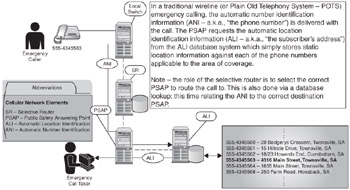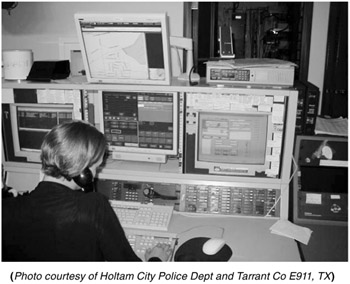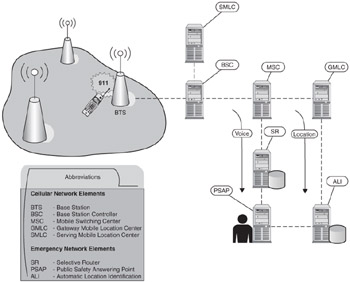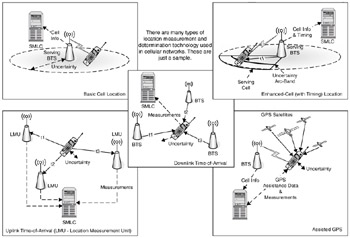Emergency Services: A Case Study of an Important Location-Based Service
Before examining the manner in which a location services infrastructure may be introduced into Internet protocols, it is useful to look at the model and mechanisms implemented in a cellular network supporting E911 in North America. In order to support this service, functionality has to be provided with ubiquitous coverage and a consistent implementation that makes the service transparent regardless of the mobility of the users and their devices.
Cellular Network Architecture for North American Emergency Services
In 1996, the Federal Communications Commission in the United States issued an order that required cellular network operators to provide the mobile equivalent of the enhanced-911 (E911) service that had been available to wired telephony users for a number of years prior. The E911 service provides not just a common emergency service number but it also delivers the caller's phone number (automatic number identification-ANI) and their location (automatic location identification-ALI) to the emergency services call center operator.
For wireline telephone networks, of course, the ALI information was provided as a civic address and this was obtained by a database lookup using the ANI to obtain the subscriber address information associated with that number, as shown in Figure 1.3.

Figure 1.3: ANI-ALI in the emergency network-a wireline phone lookup.
The challenge for cellular network operators was how to determine and deliver the ALI information when, being a mobile network, there was no strict association between the ANI and the device location. In addition, it was recognized at an early stage that it was not practical to deliver a definitive civic address form of location when any mechanism used to locate a mobile phone would have an uncertainty associated with it. For cellular networks, it would ultimately be necessary for the public safety answering points (PSAPs-where the call center operators work) to be upgraded so that they could display a geodetic form of location including the uncertainty associated with the location of callers. So, in recent years, PSAPs have been installing geographic information systems (GISs) which can overlay geodetic coordinates on maps of the emergency jurisdiction to provide the necessary information for emergency service dispatch. An example can be seen in the following illustration of a PSAP operator position where the graphical display for GIS information is part of the workstation equipment.

Reference may be made to Figure 1.4 which shows the typical functional elements of a GSM cellular network and the emergency services network that it delivers calls to. There are two critical aspects to this network architecture which would not be seen in a wireline network context. The first is the location services (LCS) infrastructure which exists in the cellular network side. This is primarily represented by the mobile location center (MLC) components; the serving MLC (SMLC) invokes network and/or handset measurements and performs calculations using those measurements to obtain a geodetic form of the location of the handset. The gateway MLC (GMLC) stores those measurements for presentation on request from the emergency network.

Figure 1.4: Atypical GSM cellular network emergency service architecture.
The second critical aspect is the automatic location identification (ALI) database which services the requests for location information from the PSAP, and which supports a real-time query interface to the GMLC operating in the cellular network. When the PSAP requests location information for the caller, it queries the ALI just as it would do for a wireline caller. The ALI then proxies this request to the GMLC in the cellular network, which has the caller's location stored. The GMLC responds with the caller's location. The ALI then proxies the response back to the PSAP together with appropriate indicators of the nature of the call, such as the fact that this is cellular and the provided location is in the geodetic form. Further, since the caller can be mobile, the PSAP can request updates on the location of the caller and the ALI will also proxy these subsequent requests to the GMLC. The GMLC will then initiate requests for updated locations through the cellular network to the SMLC. The paths of the voice and location information in the cellular example are also shown in Figure 1.4. Note that the location information follows a different path than the voice traffic.
Location Determination in Cellular Networks
There is a wide range of mechanisms through which location is determined in cellular networks, and some of these mechanisms are shown in Figure 1.5. The SMLC may simply obtain the identity of the serving cell in the network and, based on the location of the BTS associated with that cell, determine an approximate location of the handset. This location will typically be geodetic coordinates and a radius value representing the area of uncertainty associated with the location. The size of the uncertainty area will depend on the overall size of the cell serving the handset; the bigger the cell, the greater the overall uncertainty with respect to the location of the handset.

Figure 1.5: Location technologies in cellular networks.
The location calculation can be refined further with the aid of additional measurements taken by the SMLC. The measurements may be of signal timings, the strength of received signals, or the angle of arrival of signals at the base stations. In addition, the SMLC may request measurements from the handset. These may also be network measurements, including signal strengths and timing, or they may be of some external system such as the satellites in the global positioning system (GPS). Note that, with the exception of GPS, none of the measurements are a direct representation of location but, rather, something that can be used in conjunction with some other contextual information so that location can be calculated. Even in the case of GPS, the SMLC may ask for just the raw GPS measurements (the code phase offsets) from which ranges to the satellites can be determined and which may also be used in combination with other network measurements to improve the yield of GPS on its own. In order to calculate location, the SMLC has to have the necessary contextual information, such as the current location of the GPS satellites and base stations that the measurements relate to.
It can be seen that there are many "technologies" that can be applied to the process of location determination even in the specific field of cellular networks. However, all of these technologies can be characterized by the particular types of the parameters that are measured and the specific algorithms and necessary context information that permit a location to be calculated from those measurements. Regardless of the technology used to calculate it, the location information is rendered in a common form. In the cellular domain, this form is typically geodetic, with an associated area of uncertainty. This form is then presented to the application layer, such as the emergency services network, so that the details of location calculation are transparent to the application. Indeed, the actual network technology need not be visible to the services. For example, the device may be situated in a GSM, TDMA, UMTS, or CDMA network, but the nature of the location information remains unchanged because the type of network is not necessarily significant to the service using the location.
At this point, it is worth pausing to highlight three key concepts:
-
Location measurement Obtaining the value of specific key and transient parameters associated with a target device which will be useful in determining location
-
Location determination Combining a set of measured parameters with contextual data and algorithms to calculate a location
-
Location acquisition Providing location information in an understood and consistent form to a recipient entity
In the simple example of an enhanced cell measurement in a cellular network, and with reference to Figure 1.6:
-
The measurements include the value of the serving cell identifier and a timing measurement indicating how long signals take to go from the BTS to the handset.
-
Location determination involves the use of the contextual information of the latitude and longitude of the BTS, the angular orientation and the number of degrees of opening of the serving cell. The algorithm calculates the distance from the BTS using the timing measurement and a corresponding margin of error and ultimately determines a specific arc-band within the serving cell sector that represents the area that the handset should be in to within a specific degree of confidence.
-
The SMLC then takes that location information and encodes it in a standards-defined form for transmission through the network for acquisition by the using application. In the case of E911, this is via the GMLC, the ALI, and then on to the PSAP.

Figure 1.6: TA breakdown
This separation between the process of collecting measurements, the process of calculating location, and the mechanism by which location information is acquired by users is a general model that is applicable beyond the specific domain of cellular network location. Indeed, it forms the basis for a generic architecture applicable to any sort of network, and in particular-from the perspective of this text-the various sorts of Internet protocol access networks.
EAN: 2147483647
Pages: 129